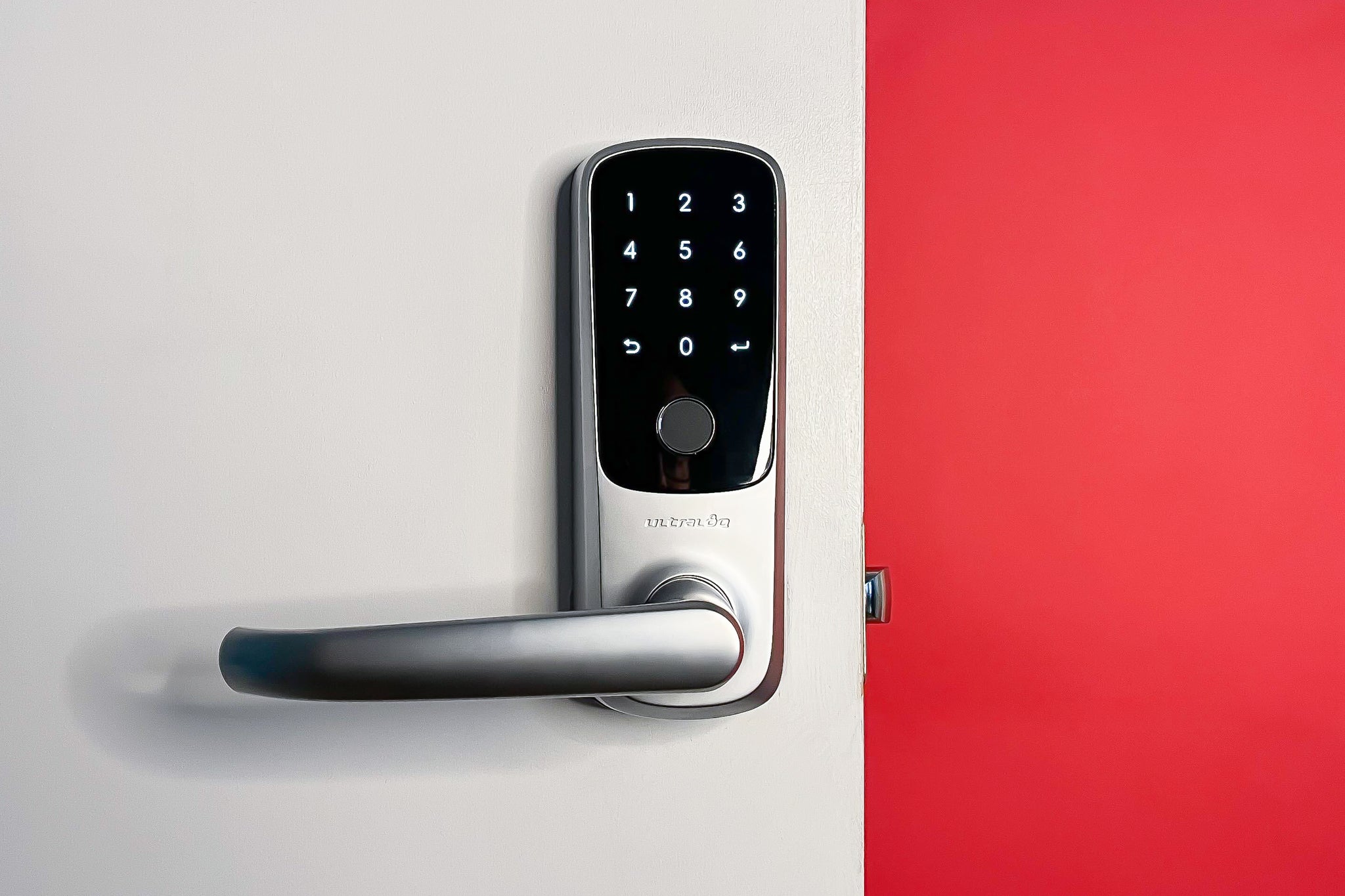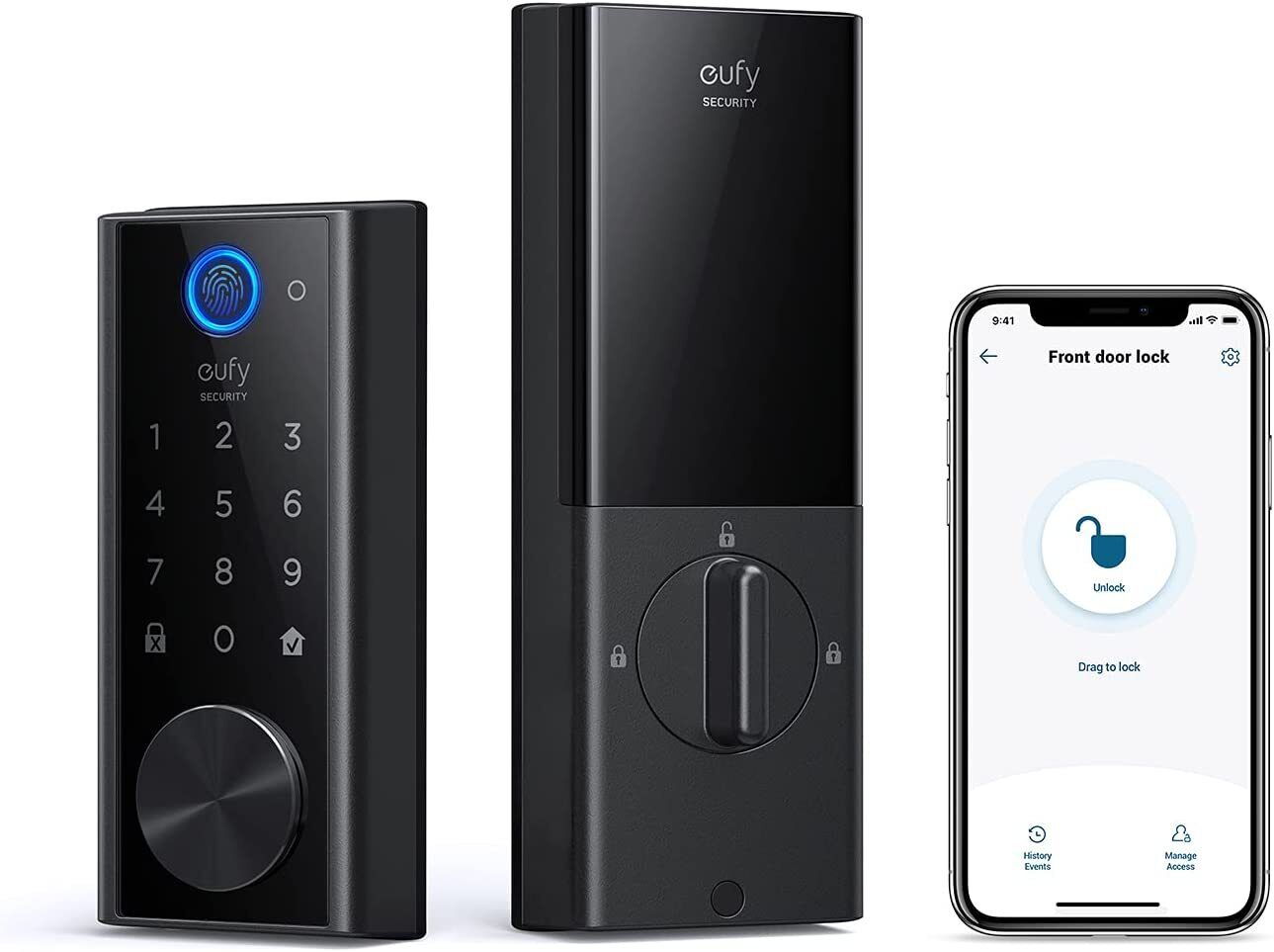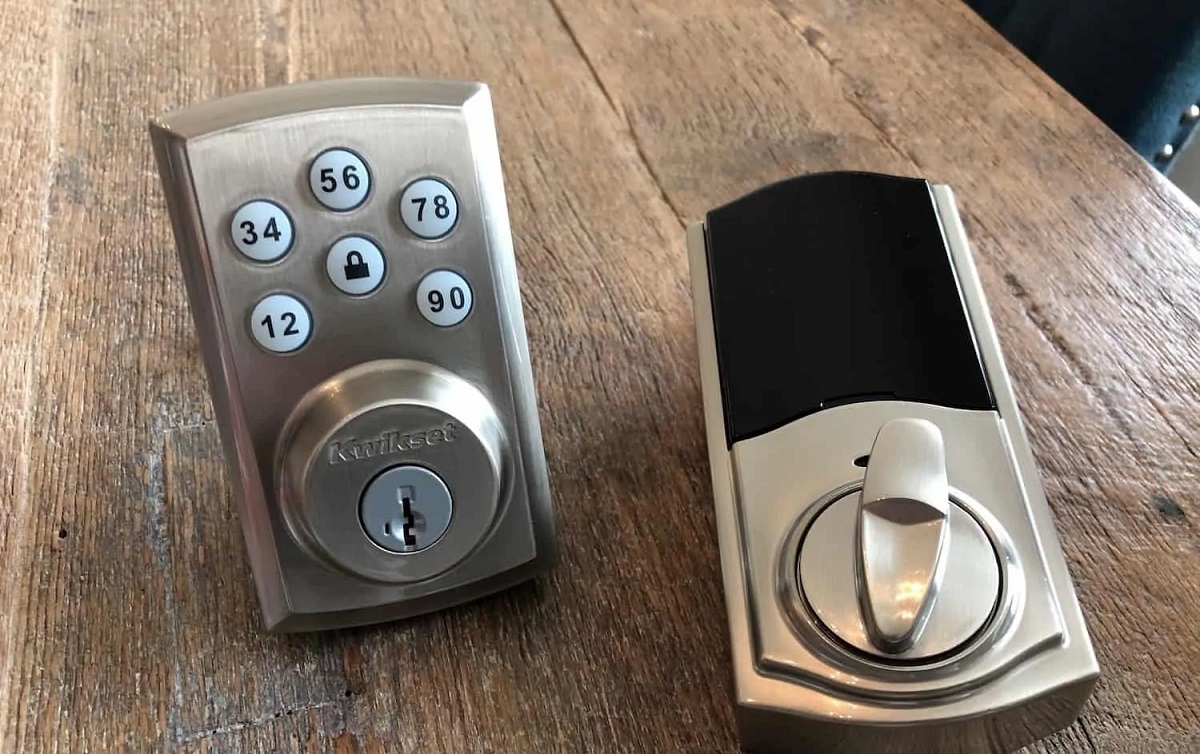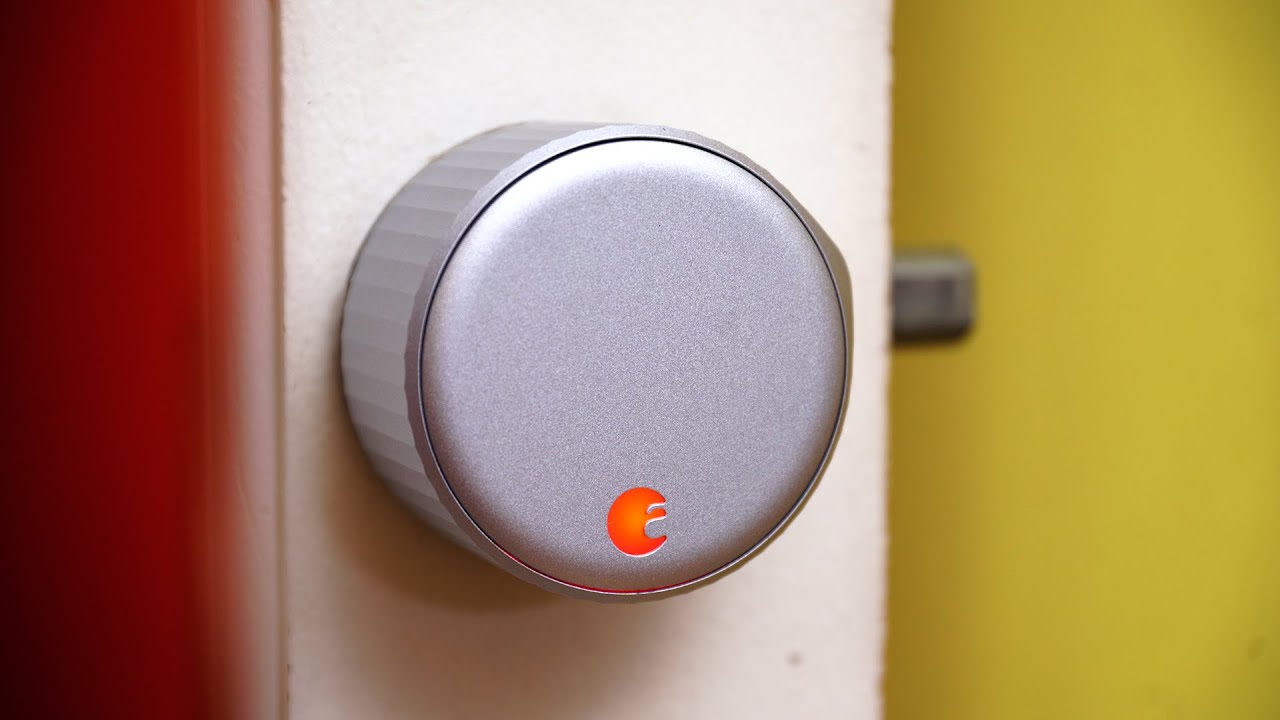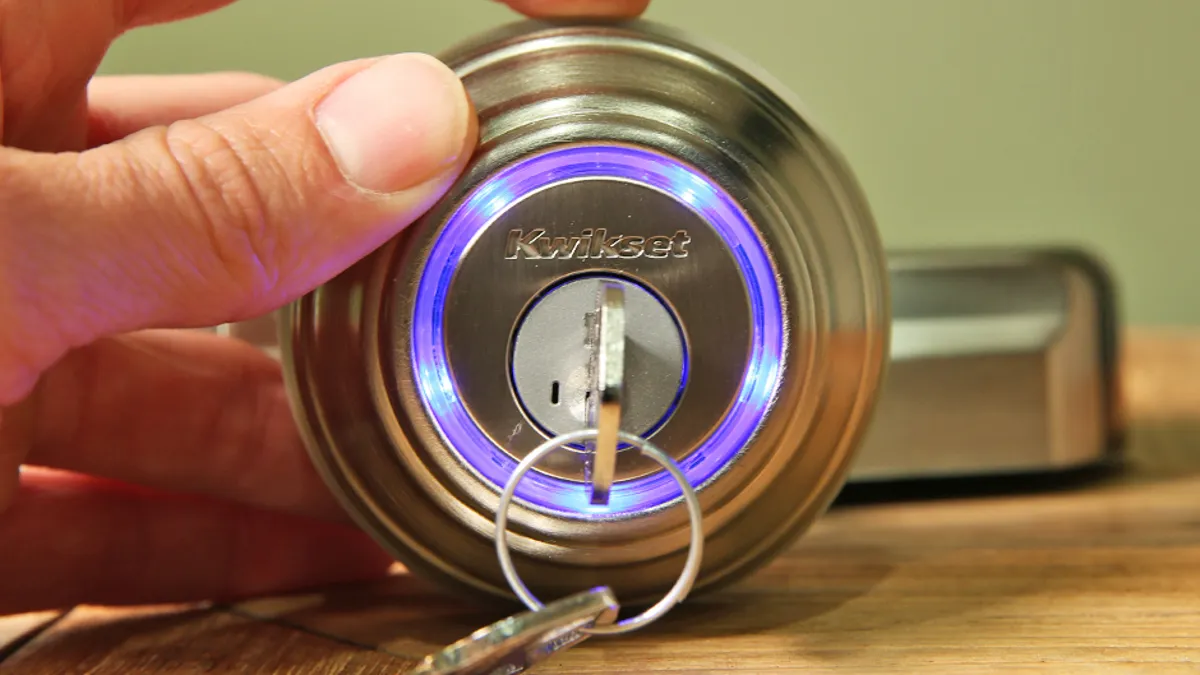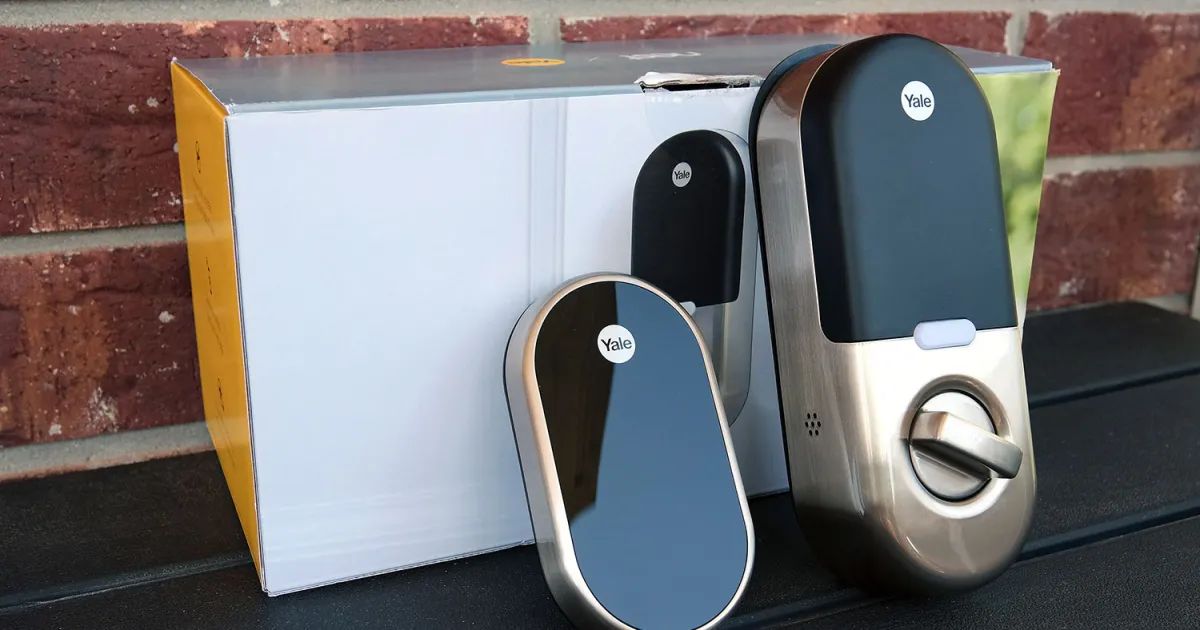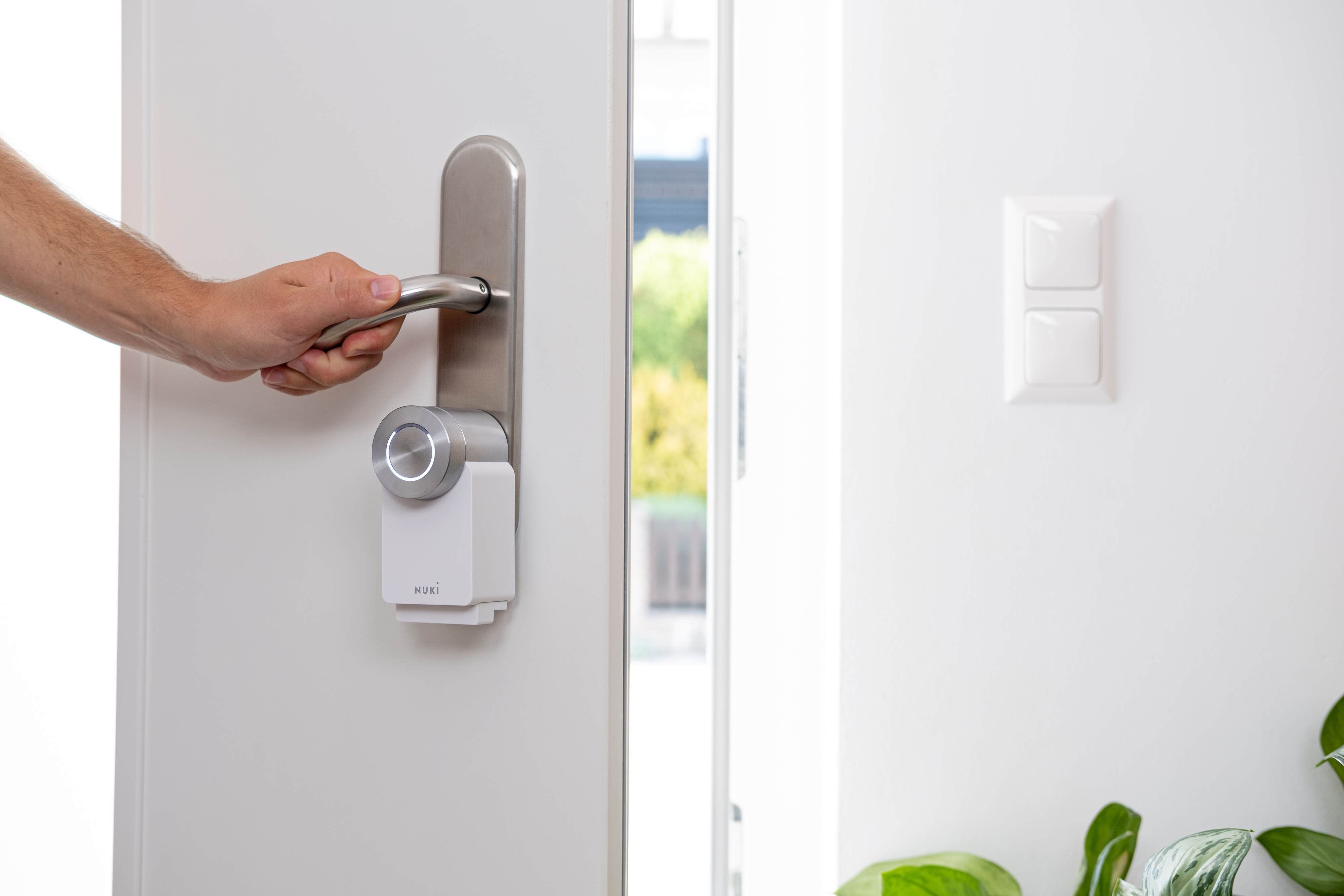Introduction
Welcome to the future of home security! With the rise of smart home technology, traditional locks are being replaced by the convenience and innovation of smart locks. Smart locks offer an array of features and functionalities that give you increased control and peace of mind over the security of your home.
In this article, we will guide you through the process of using a smart lock and help you understand how it can revolutionize the way you protect your home. Whether you’re a tech enthusiast or just looking to upgrade your home security, this guide will provide you with the knowledge you need to make the most out of your smart lock.
Before we delve into the details, it’s important to note that smart locks come in different types and variations, each with its own set of features and installation procedures. It’s crucial to choose the right smart lock that fits your specific needs and meets your security requirements.
In the following sections, we will cover the key aspects of using a smart lock, including choosing the right lock, installation, setup, connecting to your smartphone, customizing settings, managing access, troubleshooting common issues, and enhancing security.
By the end of this article, you’ll have a thorough understanding of how to use a smart lock, empowering you to take full advantage of its features and experience a seamless and secure home entry system.
Choosing the Right Smart Lock
When it comes to choosing a smart lock for your home, there are several factors you should consider. The sheer variety of options available can be overwhelming, but by understanding your specific needs and doing some research, you can find the perfect smart lock for your home. Here are some key factors to consider during the selection process:
- Compatibility: Ensure that the smart lock you choose is compatible with your existing door and lock setup. Some smart locks work with traditional deadbolts, while others require a full replacement.
- Connectivity: Decide whether you want a smart lock that connects to your home’s Wi-Fi network or one that uses Bluetooth to communicate with your smartphone. Wi-Fi-enabled smart locks offer remote access and control, while Bluetooth locks typically require you to be in close proximity to the lock.
- Security Features: Look for smart locks with robust security features such as advanced encryption, two-factor authentication, and tamper detection. Consider locks that have undergone independent security assessments and have received certifications.
- Battery Life: Check the battery life expectancy of the smart lock. Look for locks that come with long-lasting batteries or feature low-battery indicators to alert you when it’s time to replace them.
- Integration: Consider whether you want a smart lock that integrates with other smart home systems, such as voice assistants or security systems. Integration allows you to control your lock through a centralized platform.
- User-Friendly Interface: Choose a smart lock with an intuitive mobile app or user interface. The app should provide a seamless experience for managing access, customizing settings, and receiving notifications.
- Budget: Set a budget for your smart lock purchase. While there are budget-friendly options available, keep in mind that investing in a high-quality smart lock with advanced features usually pays off in terms of security and convenience.
By considering these factors, you can narrow down your options and choose the perfect smart lock that aligns with your preferences and requirements. Remember to read reviews and consult with professionals or experienced users to gain valuable insights before making your final decision.
Understanding the Basics of Smart Locks
Before diving into the world of smart locks, it’s essential to understand the core features and functions that make them stand out from traditional locks. While smart locks may vary in terms of design and specific features, they share some fundamental aspects that set them apart. Let’s explore the basics of smart locks:
Keyless Entry: One of the most significant advantages of a smart lock is the ability to eliminate the need for traditional keys. Instead, you can use alternative methods such as a smartphone app, keypad, fingerprint scanner, or even voice recognition to unlock and lock your door.
Remote Access: Unlike traditional locks, smart locks allow you to remotely control and monitor your lock’s status from anywhere. Whether you’re at work or on vacation, you can use a mobile app to lock or unlock your door, receive real-time notifications, and grant access to guests or service providers.
Access Control: With a smart lock, you have precise control over who can enter your home and when. You can create temporary or recurring access codes for family members, friends, or delivery persons. This feature is especially useful for granting access to guests without the need for physical keys.
Activity Logs: Smart locks keep a detailed log of all lock activities, allowing you to monitor who has entered or left your home and at what time. This log can be especially useful in case of a security breach, as it provides valuable information for investigation.
Smart Home Integration: Many smart locks can be integrated into larger smart home ecosystems. This integration allows you to control your lock alongside other connected devices, such as doorbell cameras, security systems, or voice assistants. You can create automation routines to ensure that your door is locked when you leave or unlocked when you arrive home.
Battery-Powered: Smart locks are powered by batteries, which means they can continue to operate even during a power outage. It’s essential to keep track of the battery level and replace them as needed to ensure uninterrupted functionality.
Enhanced Security: Smart locks often come with advanced security features to protect against unauthorized access. These can include encryption protocols, tamper detection, and two-factor authentication. However, it’s important to choose a reputable and trusted brand to ensure the highest level of security.
By understanding these fundamental aspects of smart locks, you can fully appreciate their capabilities and make the most of their features. In the next sections, we will explore how to install, set up, and customize your smart lock to suit your preferences and enhance your home’s security.
Installing Your Smart Lock
Installing a smart lock may sound intimidating, but with the right tools and a little patience, it’s a manageable task for most homeowners. The installation process can vary depending on the type and model of the smart lock, so be sure to carefully read and follow the manufacturer’s instructions. Here’s a general guide to help you through the installation:
- Gather the necessary tools: Before starting the installation, make sure you have all the required tools handy. These typically include a screwdriver, measuring tape, and any additional tools specified by the manufacturer.
- Prepare your door: Inspect your door to ensure it’s in good condition and suitable for a smart lock. Check that your door is properly aligned, the deadbolt is functioning smoothly, and there is enough space for the smart lock to fit without obstruction.
- Remove the existing lock: If you have a traditional lock in place, carefully remove it according to the manufacturer’s instructions. This usually involves removing the screws securing the lock plate and latch assembly.
- Attach the smart lock: Follow the manufacturer’s instructions to attach the smart lock to your door. This typically involves sliding the lock mechanism into the existing deadbolt hole and securing it in place with screws or other provided mechanisms.
- Connect the smart lock: Once the lock is attached, connect any necessary cables or wires according to the instructions. Some smart locks require additional wiring for power or connectivity.
- Test the lock: Before completing the installation, test the smart lock to ensure it functions properly. Check that the lock mechanism smoothly engages and disengages, and that it properly locks and unlocks with the provided keys or via the smartphone app.
- Install batteries: If your smart lock is battery-powered, install the required batteries according to the instructions. Ensure the batteries are correctly inserted and have a sufficient charge.
- Secure any additional components: If your smart lock comes with additional components, such as a keypad or a decorative cover, follow the manufacturer’s instructions to attach and secure them.
- Follow setup instructions: After the physical installation, the next step is to follow the setup instructions provided by the manufacturer. This typically involves downloading the companion mobile app and connecting your smart lock to your Wi-Fi network.
Remember to take your time during the installation process and refer to the manufacturer’s instructions for any specific details or considerations. If you encounter any difficulties or have questions, don’t hesitate to consult with the manufacturer’s support or seek professional assistance.
Setting up Your Smart Lock
Once you have successfully installed your smart lock, the next step is to set it up and personalize it according to your preferences. Setting up a smart lock is typically done through a companion mobile app that allows you to control and manage your lock’s features. Here are the general steps to follow to set up your smart lock:
- Download the companion app: Visit the app store on your smartphone and search for the companion app provided by the smart lock manufacturer. Download and install the app on your device.
- Create an account: Open the app and create an account if required. This will allow you to securely access and control your smart lock remotely.
- Connect your smart lock to the app: Follow the instructions provided by the app to connect your smart lock to your smartphone. This usually involves scanning a QR code or entering a unique code provided with your lock.
- Set up administrative access: As the owner of the smart lock, you will typically have administrative access and control over the lock’s settings. Set up a unique username and password to secure your administrative access to the lock.
- Configure basic settings: Through the app, you can configure basic settings such as the lock’s name, time settings, and language preferences. Customize these settings according to your preferences.
- Set up user access: Determine who else will have access to the smart lock and set up user profiles accordingly. This can include family members, friends, or trusted individuals who need to enter your home.
- Create access codes: Within the app, you can create unique access codes for each user. These codes can be used to unlock the door without the need for physical keys, providing convenient access for authorized individuals.
- Assign access schedules: If you want to control when certain access codes are valid, you can assign access schedules. For example, you can set up temporary codes for guests that only work during their stay.
- Explore additional features: Take some time to explore the app and familiarize yourself with any additional features your smart lock offers. This may include features like geofencing, which automatically locks or unlocks the door based on your smartphone’s location.
Remember to consult the manufacturer’s instructions and the app’s user guide for specific details on setting up your smart lock. By taking the time to personalize your smart lock’s settings, you can ensure a seamless and tailored experience that enhances your home security.
Connecting Your Smart Lock to Your Smartphone
One of the key benefits of a smart lock is the ability to control and monitor it remotely using your smartphone. Connecting your smart lock to your smartphone allows you to unlock or lock your door, receive real-time notifications, and manage access codes from anywhere. Here’s how to connect your smart lock to your smartphone:
- Ensure compatibility: Make sure your smart lock and smartphone are compatible. Check the manufacturer’s specifications to confirm if your smartphone’s operating system is supported.
- Download the companion app: Visit the app store on your smartphone and search for the companion app provided by the smart lock manufacturer. Download and install the app on your device.
- Create an account: Open the app and create an account if required. This will allow you to securely access and control your smart lock remotely.
- Enable Bluetooth or Wi-Fi: Depending on the type of smart lock you have, you may need to enable either Bluetooth or Wi-Fi on your smartphone. Check the manufacturer’s instructions to determine the necessary connectivity method.
- Put your smart lock into pairing mode: Follow the manufacturer’s instructions to put your smart lock into pairing mode. This usually involves pressing a button or entering a specific code on the lock itself.
- Pair your smart lock with your smartphone: Open the companion app on your smartphone and follow the on-screen instructions to pair your smart lock. This may involve scanning a QR code, entering a code, or selecting your lock from a list of available devices.
- Follow app prompts: Once your smart lock is successfully connected to your smartphone, the app will guide you through the initial setup process. This may include configuring basic settings, setting up administrative access, and creating user profiles.
- Test the connection: After completing the setup process, test the connection between your smart lock and smartphone. Lock and unlock the door using the app to ensure that the commands are accurately received and executed by the lock.
- Explore additional features: Take some time to explore the app and familiarize yourself with any additional features that come with your smart lock. This may include features like geofencing, which automatically locks or unlocks the door based on your smartphone’s location.
Remember to refer to the manufacturer’s instructions and the app’s user guide for any specific details on connecting your smart lock to your smartphone. By successfully connecting your smart lock to your smartphone, you’ll have convenient access and control over your lock, enhancing the security and convenience of your home.
Customizing Your Smart Lock’s Settings
Once you have connected your smart lock to your smartphone, you can start customizing its settings to suit your preferences and enhance your home security. Customizing your smart lock’s settings allows you to personalize its behavior, access control, and notifications. Here are some settings you can consider modifying:
- Lock sensitivity: Adjust the lock sensitivity settings to ensure that the lock mechanism engages and disengages smoothly. This will help prevent any issues with locking or unlocking your door.
- Auto-locking feature: If supported by your smart lock, enable the auto-locking feature to automatically lock the door after a specified period of time. This offers peace of mind by ensuring the door is locked even if you forget to do so manually.
- Notification preferences: Customize the notification settings to receive alerts and updates regarding the status of your smart lock. You can choose to be notified when the door is locked or unlocked, when access codes are used, or when the battery is running low.
- Access code management: Manage and customize access codes for yourself and other authorized users. You can create, modify, or delete access codes as needed, granting temporary or permanent access to individuals.
- Schedule-based access: Take advantage of the schedule-based access feature to specify when certain access codes are valid. This allows you to control when individuals can enter your home, limiting access during specific times.
- Integration with other smart devices: If your smart lock integrates with other smart home devices, explore the settings related to integration. You may be able to create automation routines that coordinate the lock with other devices, such as turning off lights when the door is locked.
- User profiles: Within the app, you may have the option to create user profiles for different individuals. Customize these profiles with unique settings and access privileges to provide a tailored experience for each user.
- Guest access management: If you frequently host guests or have service providers accessing your home, consider utilizing the guest access management settings. This allows you to create temporary access codes for limited periods of time, providing convenience and security.
- Security features: Explore the security-related settings of your smart lock. Enable features such as two-factor authentication or tamper detection to enhance the overall security of your lock and protect against unauthorized access.
- Language and display preferences: Customize the language and display preferences of your smartphone app to ensure a user-friendly experience. Choose the language that you are most comfortable with and modify the display settings to suit your preferences.
Remember to consult the manufacturer’s instructions and the app’s user guide for specific details on customizing your smart lock’s settings. By taking the time to personalize these settings, you can ensure that your smart lock operates in a way that aligns with your lifestyle and enhances the security and convenience of your home.
Managing Access to Your Smart Lock
One of the key advantages of a smart lock is the ability to easily manage and control access to your home. With a few taps on your smartphone, you can grant or revoke access for individuals, track entry history, and ensure the security of your property. Here are some ways to effectively manage access to your smart lock:
- Assign unique access codes: Create unique access codes for individuals who need entry to your home. This eliminates the need for physical keys and allows you to easily track who is entering and leaving.
- Control access schedules: Determine when certain access codes are active by setting up access schedules. This feature allows you to restrict access during specific hours or days, providing added security and control.
- Create temporary codes: For guests or service providers who need temporary access, create one-time or limited-use access codes. This prevents unauthorized access after their designated time frame has ended.
- Manage access remotely: With a smart lock connected to your smartphone, you can manage access from anywhere. Whether you’re at work, traveling, or simply away from home, you can grant or revoke access codes using the companion app.
- Receive activity notifications: Enable notifications to receive real-time alerts whenever your smart lock is unlocked or locked. This allows you to stay informed about who is accessing your home and monitor any suspicious activity.
- Regularly review access permissions: Regularly review the access permissions and codes assigned to individuals to ensure they are up to date. Remove access for individuals who no longer require entry to maintain tight control over who can enter your home.
- Monitor entry history: Take advantage of the entry history feature provided by your smart lock. This allows you to review a log of who has accessed your home and at what time, providing an extra layer of security and accountability.
- Communicate access changes: Communicate any access code changes or updates to individuals who have been granted access. This ensures that they are aware of any modifications and can use the correct access codes when needed.
- Share access with trusted individuals: For added convenience and security, share access to your smart lock with trusted family members or friends. This allows them to enter your home in case of emergencies or when you are unavailable.
- Regularly update security settings: Stay up to date with the latest security features and updates provided by the smart lock manufacturer. Regularly update your lock’s firmware and security settings to ensure the highest level of protection.
By effectively managing access to your smart lock, you can maintain control over who enters your home, track entry history, and ensure the overall security of your property. Take advantage of the features provided by your smart lock and companion app to streamline the access management process and enjoy the convenience and peace of mind it offers.
Troubleshooting Common Smart Lock Issues
Like any electronic device, smart locks may encounter some issues from time to time. Luckily, many common smart lock issues can be resolved with a few troubleshooting steps. Here are some common smart lock issues and how to troubleshoot them:
- Lock not responding: If your smart lock is not responding to commands from the app or keypad, check the batteries to ensure they are properly inserted and have sufficient charge. Replace the batteries if needed and ensure that the lock is within range of your smartphone or connected hub.
- Intermittent connectivity: If you’re experiencing intermittent connectivity issues, check that your smart lock is within range of your Wi-Fi network or hub. Consider relocating your router or hub to improve signal strength. If using a Bluetooth-based lock, ensure that your smartphone is nearby and has Bluetooth enabled.
- Incorrect access codes: If access codes are not working as expected, verify that the codes are entered correctly. Check for any additional settings or restrictions (such as scheduled access) that might affect the code’s functionality. It’s also a good idea to reset the code and try again if the issue persists.
- App connectivity issues: If you’re having trouble connecting to your smart lock through the companion app, ensure that your smartphone has a stable internet connection. Restart the app and make sure you have the latest app version installed. If the issue persists, contact the manufacturer’s support for further assistance.
- Unresponsive keypad: If the keypad on your smart lock is unresponsive, check for any debris or obstructions that may be interfering with the buttons. Clean the keypad gently with a soft cloth, and make sure the lock is properly installed and aligned.
- Motor or lock mechanism issues: If you notice any issues with the motor or lock mechanism, such as unusual noises or difficulties engaging or disengaging, refer to the manufacturer’s troubleshooting guide or contact their support for assistance. Avoid attempting any repairs yourself to prevent further damage.
- Notification delays: If you’re experiencing delays in receiving notifications from your smart lock, check your smartphone’s notification settings. Ensure that the app has permission to send notifications and that the notification settings are properly configured within the app.
- Software/firmware updates: Keep your smart lock’s software or firmware up to date. Check for updates regularly and install them as instructed by the manufacturer. Updates often include bug fixes and security enhancements that can resolve common issues.
- Factory reset: If all else fails and you’re still experiencing persistent issues, consider performing a factory reset on your smart lock. This process will restore the lock to its default settings. Refer to the manufacturer’s instructions for specific steps on how to perform a factory reset.
- Technical support: If you’re unable to resolve the issue through troubleshooting, don’t hesitate to contact the manufacturer’s technical support. Their knowledgeable staff can provide further guidance and assistance tailored to your specific smart lock model.
By following these troubleshooting steps, you can address many common smart lock issues and restore optimal functionality to your lock. Remember, if you encounter any major or persistent issues, it’s best to reach out to the manufacturer’s support for expert assistance.
Enhancing Security with Your Smart Lock
While smart locks offer convenience and accessibility, they also provide an opportunity to enhance the security of your home. By utilizing the additional security features and best practices, you can maximize the protection offered by your smart lock. Here are some ways to enhance security with your smart lock:
- Enable two-factor authentication: Two-factor authentication adds an extra layer of security by requiring an additional verification step, such as a fingerprint scan or a secondary access code, along with the regular unlock method.
- Regularly update firmware: Stay up-to-date with the latest firmware updates provided by the smart lock manufacturer. These updates often include security patches and bug fixes that address any vulnerabilities found in the lock’s software.
- Choose strong access codes: When setting up access codes, choose strong and unique combinations that are not easily guessable. Avoid using common codes, such as birthdays or sequential numbers, and consider using a mix of letters, numbers, and symbols.
- Monitor access history: Review the access history log regularly to keep track of who has entered your home and when. This allows you to identify any unauthorized access attempts and take appropriate action if necessary.
- Secure app and user accounts: Protect your companion app and user accounts with strong passwords. Enable biometric authentication, such as fingerprint or facial recognition, if available on your smartphone, to ensure that only authorized individuals can access and control your smart lock.
- Use secure Wi-Fi networks: When connecting your smart lock to a Wi-Fi network, ensure that it is secure and encrypted. Avoid using public or unsecured networks that may compromise the security of your smart lock’s communication.
- Implement geofencing: Some smart locks offer geofencing capabilities, allowing them to automatically lock or unlock based on your smartphone’s location. Take advantage of this feature to ensure that your door is locked when you leave the vicinity of your home.
- Secure physical access points: While the smart lock itself provides enhanced security, it’s important to ensure that other entry points, such as windows and garage doors, are also secure. Install additional security measures, such as window locks and reinforced door frames, to deter break-ins.
- Regularly assess and update access: Continuously review access permissions and remove any unnecessary or outdated codes. Update access schedules and revoke access for individuals who no longer require it to maintain strict control over who can enter your home.
- Keep app and firmware up to date: Regularly update the companion app and smart lock firmware to take advantage of the latest security enhancements and fixes. This ensures that your smart lock remains protected against evolving threats.
By implementing these security practices, you can further enhance the security of your home with a smart lock. Remember to consult the manufacturer’s recommendations and guidelines for any specific security features or settings available with your smart lock model.
Conclusion
Congratulations on becoming familiar with the world of smart locks and understanding how to make the most of their features. By choosing the right smart lock, installing it correctly, and customizing the settings to suit your preferences, you’ve taken significant steps toward enhancing the security and convenience of your home.
Remember, a smart lock is just one component of a comprehensive home security system. It is essential to complement it with other security measures, such as surveillance cameras and robust door and window locks, to create a holistic approach to home security.
As you continue to use your smart lock, stay vigilant about updating firmware, securing access codes, and monitoring access history. Regularly review and update security settings, and address any issues or concerns promptly.
By following these best practices, you’ll ensure a seamless and secure experience with your smart lock.
Enjoy the convenience and peace of mind that come with using a smart lock, knowing that you have control over who can access your home and that your property is protected securely.
Embrace the future of home security with your smart lock and continue to explore the possibilities of smart home technology to create a safe and connected living environment.









